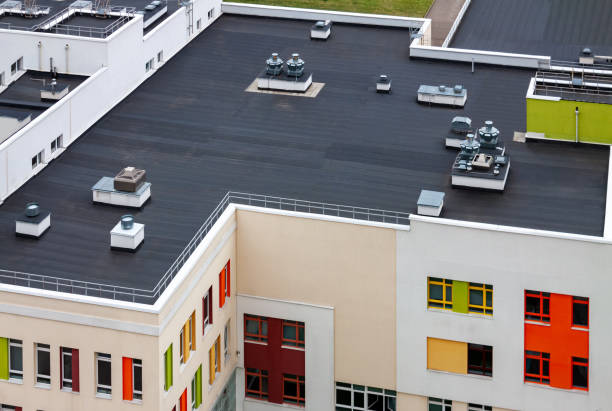If you are in the market for a new roof, you may wonder what the best material is. There are a few different options, but one of the most popular choices is flat roofing. Flat roofing, as the name depicts, is one without a peak. Many commercial buildings have flat roofs, and there are a variety of materials that can be used to cover these buildings. Flat roofs have many advantages over traditional roofs, becoming more and more popular daily.
There are a lot of factors to consider when choosing the best material for your flat roof. The most important consideration is the climate where you live. If you live in an area that experiences a lot of rain or snow, you’ll need a material that can withstand severe weather conditions. Another factor to consider is the cost of the material. Some materials are more expensive than others. Finally, you’ll need to choose a material compatible with your existing roofing system. Here are some of the best materials for flat roofs:
PVC Roofing
PVC roofing is one of the most popular roofing materials on the market today. It is made from polyvinyl chloride, a tough, synthetic plastic resistant to water damage and rot. PVC roofs are known for their durability and resistance to fire, wind, puncture, and UV, making them a popular choice for commercial and residential buildings. They are also low maintenance, so you won’t have to spend much time or money keeping them looking good. In addition, PVC roofs are available in various colors and styles, so you can find one that compliments your home’s exterior. If you’re looking for a new roof, PVC is a great option.
PVC roofing has some downsides that are worth mentioning. It’s made from nonrecyclable, toxic materials and is therefore not environmentally friendly. Repair or replacement can also be difficult when that is necessary. As for price, it isn’t the most expensive, but it’s more expensive than most materials on this list.
TPO Roofing
When it comes to commercial roofing, TPO roofing is one of the most popular choices. It was designed to be a modern replacement for PVC roofing and primarily lives up to that ideal. TPO, or Thermoplastic Polyolefin, is a single-ply roofing membrane made from a combination of polypropylene and ethylene-propylene rubber. It is designed to provide superior protection against UV rays, is heat-resistant, and is highly durable. This helps to lower cooling costs. TPO roofing is also very easy to install and repair and has a long lifespan. Lastly, TPO is a light material, making it an excellent choice for any building.
On the downside, finding contractors who work with TPO can be difficult. Also, manufacturers have not standardized everything regarding TPO, so there’s variability in performance. TPO is tough to repair because it requires heat welding and is not fireproof.
EPDM
EPDM is a rubber roofing material. It’s competitive as one of the best materials because of its good performance. It can last up to 50 years. It is easy to install, helping to save on installation costs and offset some of the material costs. It’s also affordable and easy to maintain and repair. It’s one of the very best choices for roofs prone to ponding.
One disadvantage of EPDM roofing is that the seams can become weak points that need regular repair. Also, the material’s color is black, which is terrible for cooling costs and isn’t exactly pretty.
Built-Up Roofing
Built-up roofing is one of the most common types of commercial roofing. It consists of multiple layers of asphalt, tar, or other waterproof materials, which are then covered with gravel or another protective layer. The multiple layers work together to create a durable and long-lasting waterproof barrier. Built-up roofing is often used on flat or slightly pitched roofs and can be used on any type of building. One of the main benefits of built-up roofing is its low maintenance. It is also fire resistant, and the top layer minimizes slipping risks. Once installed, it does not require much regular care or upkeep. Another benefit is that built-up roofing is very fire resistant.
One of the disadvantages of this roofing type is that it is extremely heavy. Many building structures cannot hold the weight of a built-up roof. Also, it takes much longer to install than any other roof on the list, which can increase installation costs. Lastly, finding leaks in a built-up roof can be difficult, making repairs challenging.
Modified Bitumen Roofing
If you’re looking for a durable, long-lasting roofing option, you may want to consider modified bitumen roofing. Also known as MBR, modified bitumen is a type of asphalt-based roofing reinforced with fiberglass or polyester matting. This makes it much stronger and more resistant to wear and tear than traditional asphalt shingles. Also, because of the asphalt style, it can take different colors and aesthetics, making it one of the prettier materials for flat roofs. It doesn’t have seams, making it less prone to developing leaks.
The downside of this roofing type is that it doesn’t last as long as other materials and doesn’t stand up to abuse.
So, which of these is the best for you? It depends on what your personal preference and needs. There’s a suitable choice for every situation. Most flat roofs will be best served by one of these roofing materials.
Contact The Roof Pro if you want to be sure that you’ve made the optimal choice for your roof. We work with all these materials and more, installing flat roofs throughout Central Vancouver Island. We will discuss the details with you, and you’ll surely get the right roof that meets your needs.


